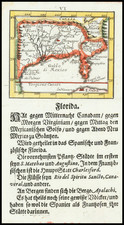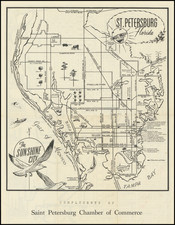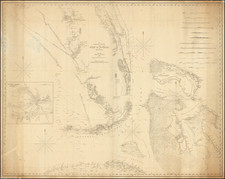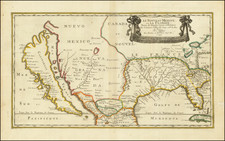Hand-colored engraving of Native Americans from Florida, that originally appeared in De Bry's Voyages. The print shows the Native Americans preparing a feast with large stews, plates, and other ongoing preparations.
This print was published in De Bry's Voyages, one of the most important collections of travel accounts of the 16th century and an early collection of tales of travel to North America.
The State Archives of Florida translates the text below the plate as follows:
At a certain time of the year, the Indians are accustomed to celebrate feasts among themselves, and for this purpose they have specially chosen cooks. They begin by putting a large, round, clay pot (so well made that water can boil in it just as well as in our vessels) on some logs which they light, while one of them holds a fan to encourage the flames. The chief cook throws what has to be cooked into the great pot; others pour water which has been brought to them in a vessel shaped like a bucket into a hole for washing; another uses a flat stone to crush the herbs to season the food; and meanwhile women are busy sorting out what is necessary for the cooking. In spite of these great feasts the Indians are very moderate in their eating, thanks to which they live to a great age. One of their chiefs asserted to me that he was three hundred years old and that his father, whom he pointed out to me, was fifty years older than he. It is true to say that on looking at him, he seemed all skin and bones. The Indians put us Christians to shame, for we, by over-indulgence in food and drink, shorten our lives considerably. We should attend the Barbarian school in order to learn temperance.
Theodor de Bry (1528-1598) was a prominent Flemish engraver and publisher best known for his engravings of the New World. Born in Liege, de Bry hailed from the portion of Flanders then controlled by Spain. The de Brys were a family of jewelers and engravers, and young Theodor was trained in those artisanal trades.
As a Lutheran, however, his life and livelihood were threatened when the Spanish Inquisition cracked down on non-Catholics. De Bry was banished and his goods seized in 1570. He fled to Strasbourg, where he studied under the Huguenot engraver Etienne Delaune. He also traveled to Antwerp, London, and Frankfurt, where he settled with his family.
In 1590, de Bry began to publish his Les Grands Voyages, which would eventually stretch to thirty volumes released by de Bry and his two sons. The volumes contained not only important engraved images of the New World, the first many had seen of the geographic novelties, but also several important maps. He also published a collection focused on India Orientalis. Les Grands Voyages was published in German, Latin, French, and English, extending de Bry’s fame and his view of the New World.

![[ Florida Indians - Preparations for a Feast ] Conviviorum apparatus By Theodor De Bry](https://storage.googleapis.com/raremaps/img/small/98462.jpg)









![[ Florida Indians ] Ceremonia a Saturioua in expeditionem adversus hostes profecturo, observatae. XI](https://storage.googleapis.com/raremaps/img/small/86474.jpg)

![[Original photograph:] Native American group image, possibly in Indian Territory, with White Settlers](https://storage.googleapis.com/raremaps/img/small/82871.jpg)

